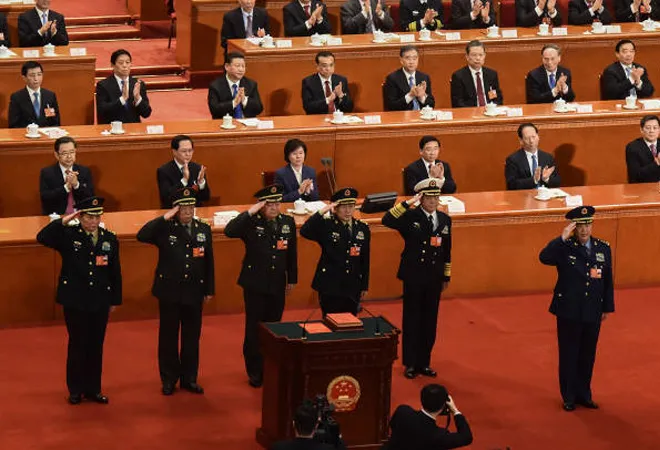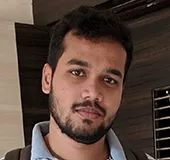-
CENTRES
Progammes & Centres
Location
The line-up of the newly appointed CMC leadership indicates that the growing tensions and economic pressure are compelling China to address regional problems

After delivering a wide-ranging work report and setting the agenda for the next five years, the Chinese Communist Party’s (CCP) General Secretary Xi Jinping finalised the members for the 20th Central Military Commission (CMC)—the highest national defence organisation of the People’s Republic of China (PRC). The CMC sits at the top of the PLA and also controls China’s domestic security forces and the People’s Armed Police (PAP). It is responsible for China’s use of the military to advance its foreign and security policy objectives and protect its national security interests. Its members are also a part of China’s National Security Commission and Foreign Affairs Commission, which determine and set China’s national security and external policies. This 20th CMC would most likely serve until the PLA completes its centenary in 2027.
The CMC sits at the top of the PLA and also controls China’s domestic security forces and the People’s Armed Police (PAP).
Besides being the centenary year, Xi also added 2027 as a short-term milestone for the modernisation of the armed forces. In the 2021 National People's Congress (NPC), Xi codified a new military modernisation goal into its national development blueprint for the PLA to achieve by centenary—to “ensure the achievement of the 2027 centennial military building goal” (quebao 2027 nian shixian jianjun bainian fendou mubiao). As Taylor Fravel, China Military Scholar, highlights, this means the 2027 goal remains a waypoint for the 2035 informatisation target to achieve military modernisation. Thus, the next five years are crucial for the PLA, and the current CMC will dictate the pace of China's military reforms and determine the role of the PLA in the PRC's regional conflicts and disputes.
Like last time, it is a seven-member CMC. However, unlike the 19th CMC, which had a relatively diverse representation from multiple services, the latest CMC is dominated by the PLA Army. Except for Xi Jinping, three members in the current CMC are from the PLA Army, one from the PLA Navy (PLAN), one from the PLA Rocket Force (PLARF) and one from the PLA Strategic Support Force (PLASSF) (Refer to Table 1). However, Adm Miao Hua was formerly from the PLA Army, has served as a political commissar of the Lanzhou Military Region. Similarly, Gen Zhang Shengmin was also formerly with the army. This makes at least five of the six members besides Xi who are related to the PLA Army. Thus, in the current CMC, there is no representation for the PLA Air Force (PLAAF) and the PLA Joint Logistic Support Force (PLAJLSF), and nominal representation of the PLAN and PLASSF—since a couple of personnel were associated with these services for a limited time. These omissions are surprising, especially after the 2015 white paper categorically mentioned that China wants to pursue and protect its interests in the far seas. The recent report mentions “winning the local wars” (da ying jubu zhanzheng), which was a major missing from the previous work report. Perhaps the increasing tensions in the near seas and land borders and worsening economic challenges—which impact the acquisition and commissioning of vessels and aircraft—could have compelled China to pay relatively more attention to the regional problems, which is also reflected in the appointments in the CMC. The absence of PLAJLSF is also surprising, as military logistics and resources management were key themes of Xi’s latest work report. It’s a bit early to predict how these appointments impact the PLA’s “integrated joint operations,” which in November 2020 was revealed as the way forward for Chinese military operations and training in complex battlefields.
Furthermore, three members—Gen Zhang Youxia, Adm Miao Hua and Gen Zhang Shengmin are retained from the 19th CMC. Gen He Weidong, who is one of the two vice chairmen of CMC, has previously served as the Commander of Eastern Theatre Command (ETC), Deputy Commander of Western Theatre Command (WTC), and the Commander of WTC Army. ETC is responsible for the Taiwan contingency, and WTC is responsible for India and Bhutan. Given these two theatres' increased tensions over the last five years, his appointment indicates operational and symbolic importance. The elevated appointment as a vice chairman could perhaps, but not necessarily, mean the worsening of tensions for these two theatres in the future. Interestingly, besides Gen He, Admiral Miao had also served as a political commissar of the Lanzhou Military Region, which is now a part of WTC—a region which commands the South Xinjiang Military District, where China and India are engaged in military stand-offs since 2020.
As mentioned earlier, there is no representation of the PLAAF and the PLASSF in the 20th CMC, whereby relegating cyber to the background. Gen Li Shangfu was the Deputy Commander of the PLASSF, primarily responsible for space-related activities. He had previously spent 31 years working at the Xichang Satellite Launch Centre—including 10 years as its director. Although this indicates the importance that China gives to space warfare; its relative negligence to the cyber branch, especially after the recent work report and the 2019 defence white paper which explicitly mentioned the importance of military innovation and diffusion technologies, cyber, big data and artificial intelligence in military applications, is surprising.
The PAP is a Chinese paramilitary organisation responsible for internal security, riot control, counter-terrorism, disaster response, law enforcement and maritime rights protection.
Another important addition this time is Gen Liu Zhenli, who served as the chief of staff of PAP before he served as the chief of staff of the PLA Army. The PAP is a Chinese paramilitary organisation responsible for internal security, riot control, counter-terrorism, disaster response, law enforcement and maritime rights protection. It is also mandated to support the PLA Army during wartime. His promotion emphasises the focus on internal security under the current regime and could perhaps also indicate the worsening of the situation in Tibet and Xinjiang.
The WTC has always been overrepresented and the South Theatre Command has been underrepresented in the CMC. But this is also due to the composition and size of WTC, which includes the former Chengdu and Lanzhou Military Regions, Tibet Military District, and Xinjiang Military Districts.
However, direct representation in the CMC doesn't need to be the only way of promoting the service or theatre interests. The PLA itself has a sound hierarchy of officials at the second, third, and lower levels to promote organisational interests and continue on the track of reforms. However, as witnessed in the past, especially with the PLA Army, appointments to the CMC enable individuals to pursue certain service and theatre interests at the organisation's cost. Only time will tell if these appointments are one step forward and two steps back for the PLA.
The views expressed above belong to the author(s). ORF research and analyses now available on Telegram! Click here to access our curated content — blogs, longforms and interviews.

SuyashDesai is a research scholar studying Chinas defence and foreign policies. His research areas include Chinese security and foreign policies Chinese military affairs Chinese nuclear ...
Read More +